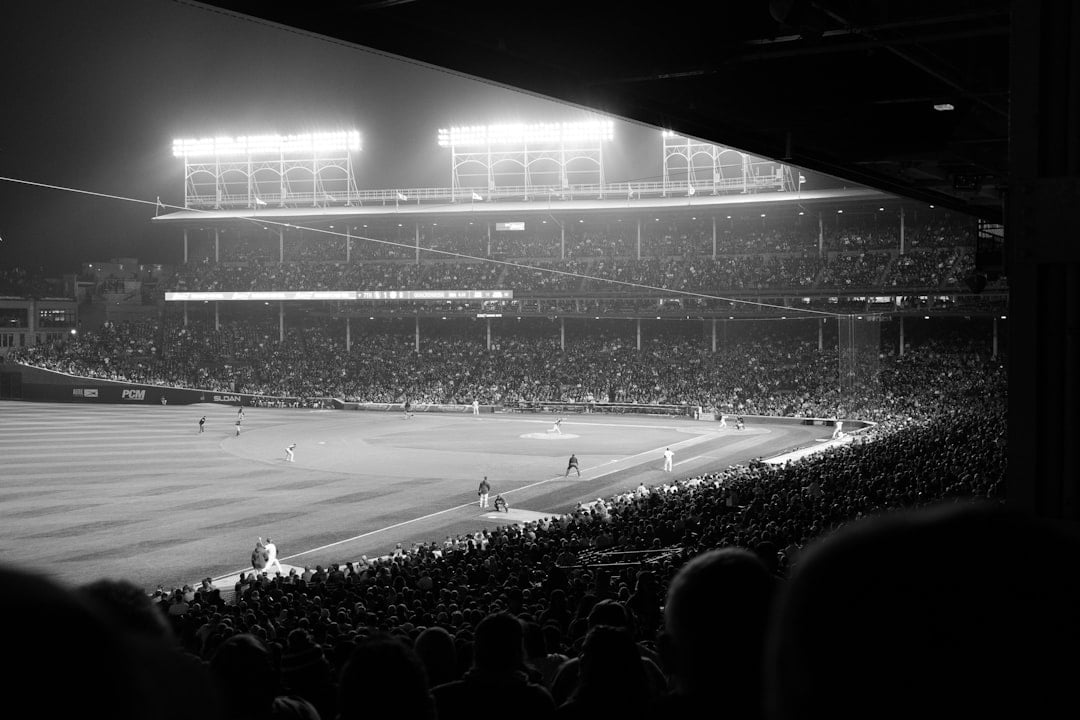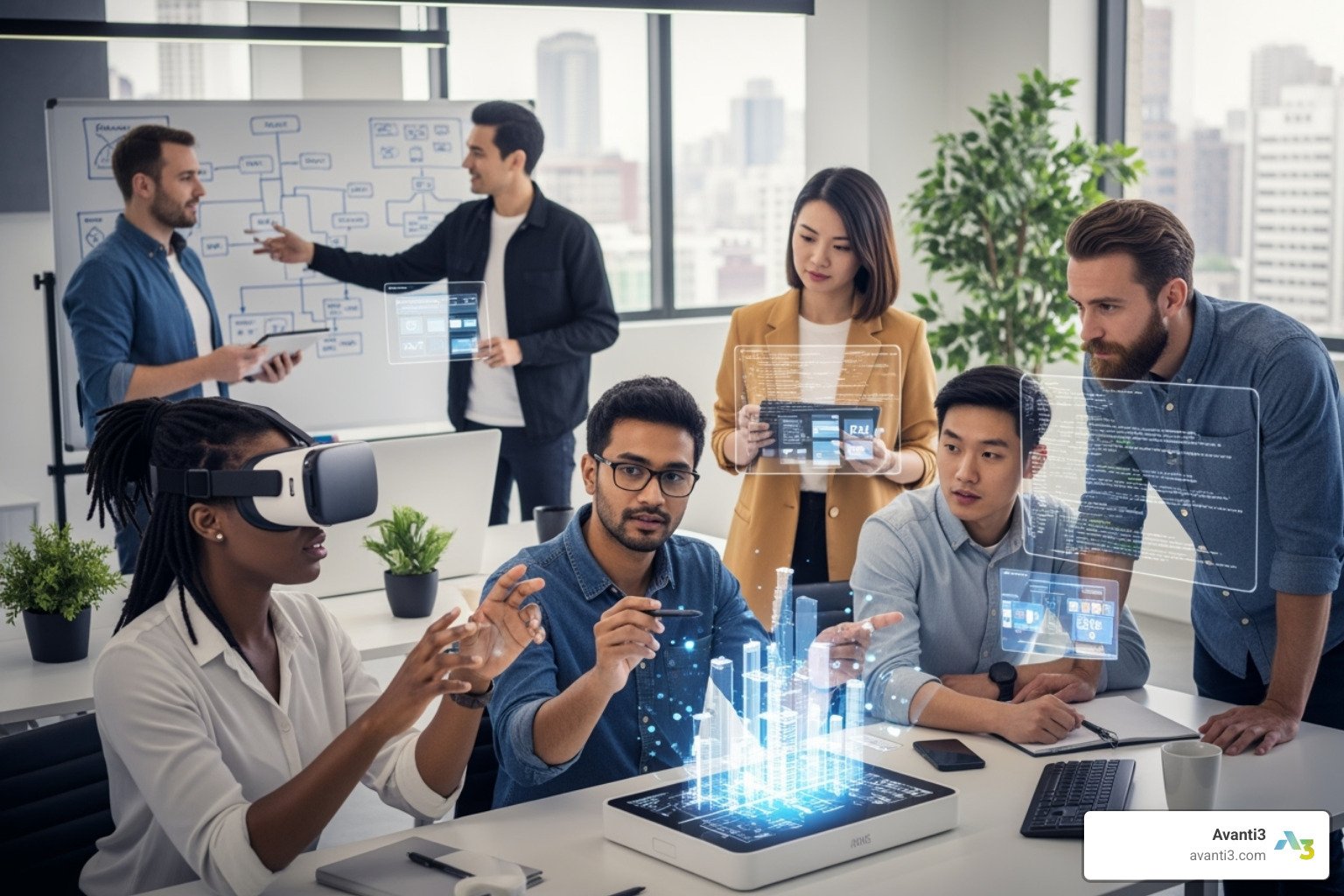Virtual reality museum: 6 Top Amazing Tours to Experience 2025
Exploring Museums Without Boundaries
A virtual reality museum is an immersive digital recreation of a museum space that allows visitors to explore exhibitions, artifacts, and artworks from anywhere in the world using VR technology.
What is a Virtual Reality Museum?
* A digital recreation of a physical museum accessible through VR headsets
* An immersive experience allowing remote exploration of art and artifacts
* A technology that makes 90% of museum collections (typically in storage) accessible
* A platform offering interactive elements not possible in physical spaces
Virtual reality museums are revolutionizing how we experience cultural heritage by breaking down physical and geographical barriers. With 79% of people worldwide expressing interest in using digital technology to explore museum collections not available to the public, VR has emerged as a powerful solution to make art and history more accessible than ever before.
The appeal is clear: imagine standing face-to-face with the Mona Lisa without the crowds, flying through the Sistine Chapel ceiling to examine Michelangelo’s brushwork up close, or traveling back in time to the opening night of the first Impressionist exhibition in Paris, 1874. These experiences are now possible through the magic of VR.
“Our research reveals a clear appetite for immersive digital experiences, with people eager to interact with cultural artefacts in new and exciting ways,” notes Professor Murray Pittock from the University of Glasgow’s Museum in My Pocket project, which is developing a two-sided XR platform for both visitors and curators.
I’m Samir ElKamouny, founder of Avanti3, where I’ve helped cultural institutions create transformative virtual reality museum experiences that engage audiences and extend the reach of their collections globally. My expertise in immersive technologies has shown me how VR can revolutionize audience engagement while preserving our cultural heritage.
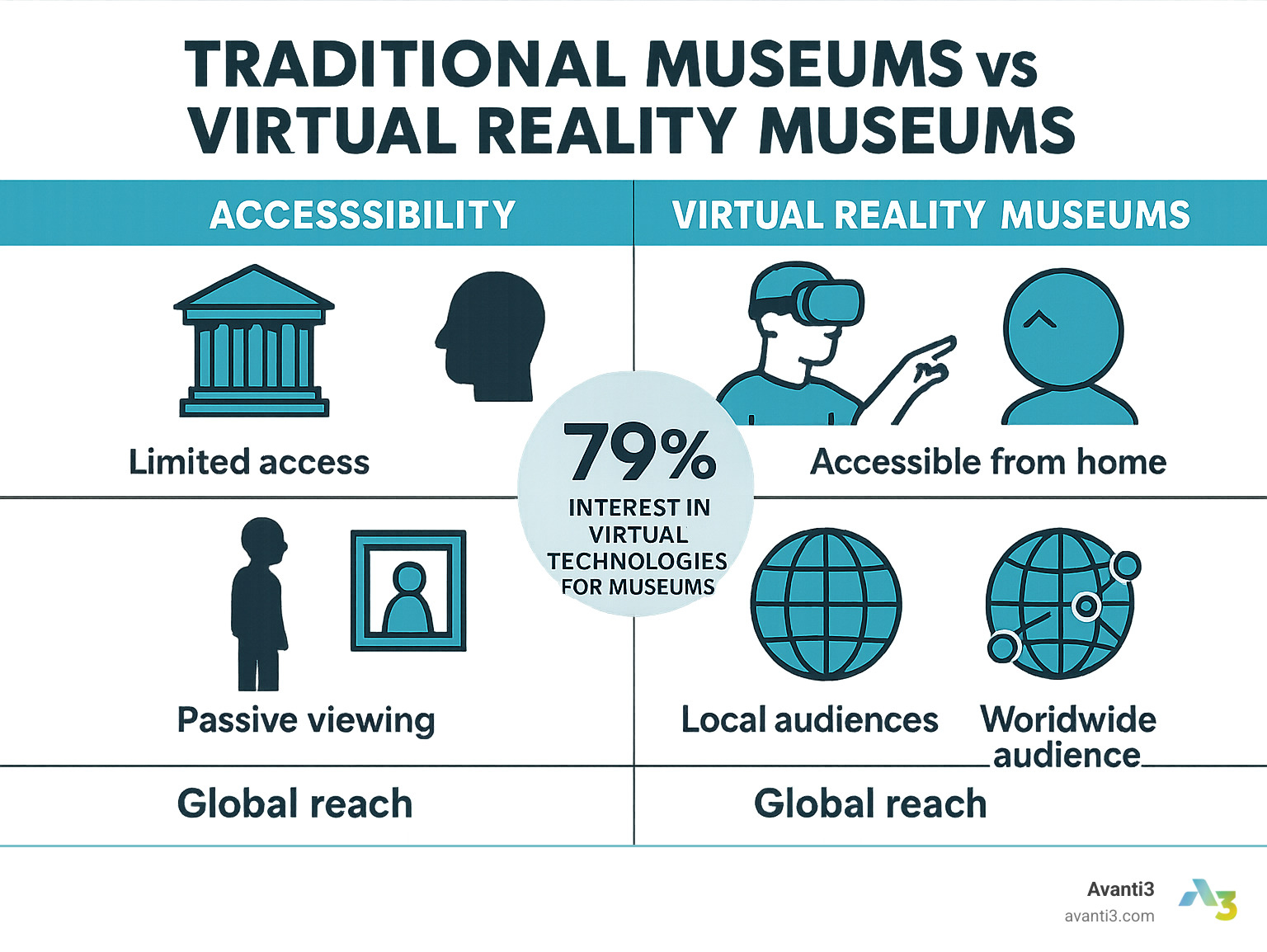
Virtual reality museum vocab explained:
– museum augmented reality
– virtual museum visit
Why Experience Museums in VR?
The statistics paint a compelling picture: approximately 90% of museum collections worldwide remain in storage, hidden from public view due to space limitations, conservation concerns, or rotating exhibition schedules. This represents an enormous wealth of cultural heritage that most people never get to experience.
Virtual reality solves this problem neatly. By digitizing collections and creating immersive environments, museums can showcase their entire archives without physical constraints. This democratization of access is particularly valuable for:
- Global audiences: People who cannot travel to distant museums due to geographic, financial, or mobility constraints
- Educational institutions: Schools can provide enriching cultural experiences without costly field trips
- Researchers and scholars: Detailed examination of artifacts without handling fragile originals
- Sustainability efforts: Reducing carbon footprints associated with international tourism
According to recent surveys, 96% of people are already familiar with VR technology, and 55% have engaged with it in some form. This growing acceptance makes virtual reality museums an increasingly viable channel for cultural engagement.
What Is a Virtual Reality Museum Tour?
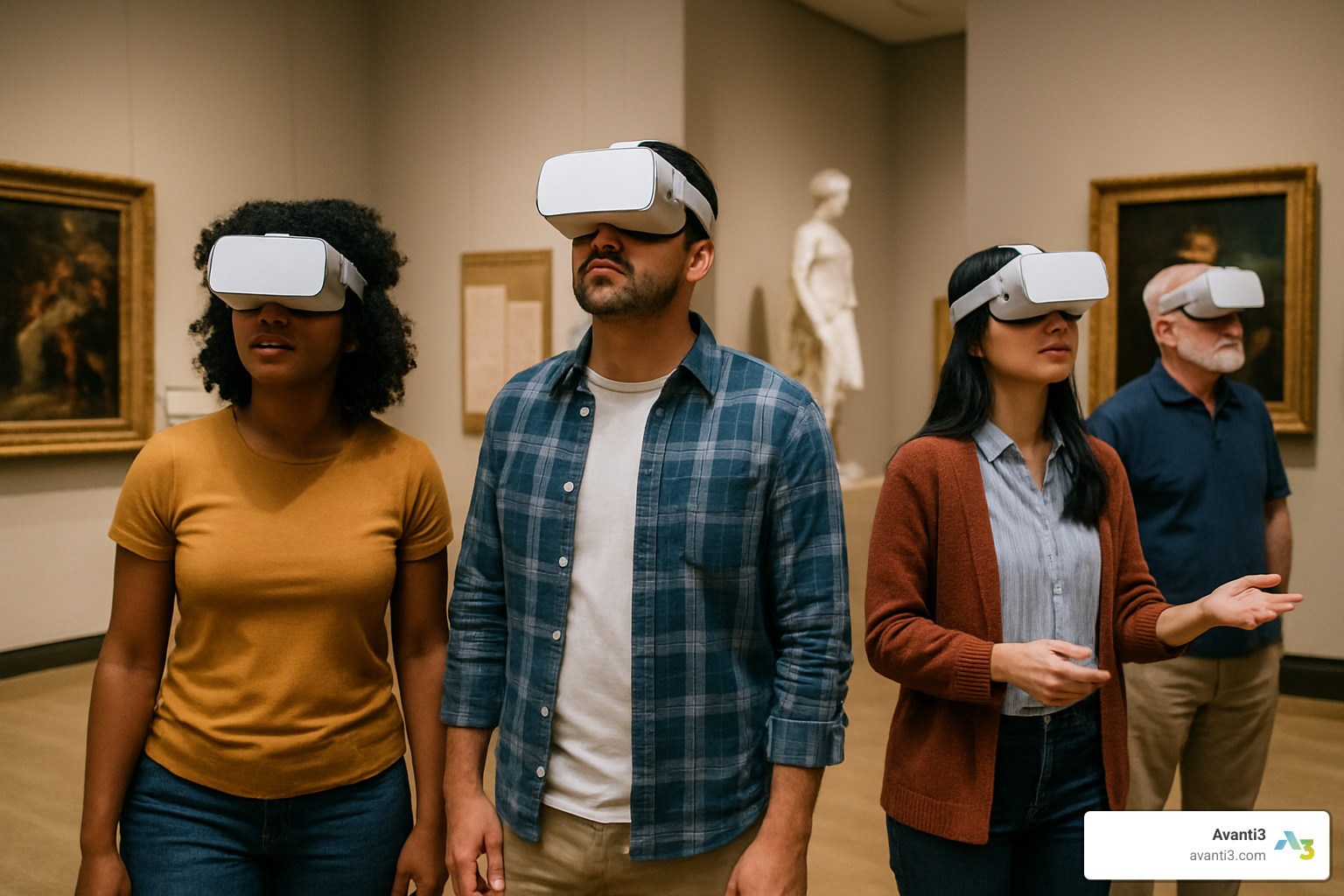
Imagine stepping through your screen and finding yourself standing before the brushstrokes of Van Gogh or wandering through ancient Roman ruins—all from your living room. This is the magic of a virtual reality museum tour.
Unlike simply clicking through photos on a website, a true virtual reality museum experience transports you into a fully realized digital environment. It’s not just about seeing art—it’s about feeling present within it. These experiences combine cutting-edge technology with thoughtful curation to create something truly special.
What makes these virtual tours different is their depth of engagement. They offer genuine immersion that tricks your senses into believing you’re physically present in another space. You have real interactivity, choosing your own path through galleries and lingering over details that catch your eye. The telepresence effect—that uncanny sensation of being transported elsewhere—can be so convincing that visitors often reach out to touch artworks that exist only in the digital field.
| Feature | Physical Museum | Virtual Reality Museum |
|---|---|---|
| Access | Limited by location, opening hours, and capacity | Available 24/7 from anywhere with internet |
| Exhibit Space | Constrained by physical building | Unlimited virtual space |
| Artifact Proximity | Roped-off, protected by glass | Up-close examination possible |
| Contextual Info | Static placards, guided tours | Interactive, multimedia, personalized |
| Conservation Impact | Physical presence can damage artifacts | Zero physical impact on originals |
| Special Needs Access | Variable accessibility features | Customizable experiences for different abilities |
| Language Support | Limited translations | Multiple languages easily implemented |
Key Benefits of a virtual reality museum experience
The power of bringing museums into the virtual field goes beyond mere convenience. Remote access fundamentally changes who can experience cultural treasures. A student in rural Thailand can now “visit” the Metropolitan Museum of Art, while someone with mobility challenges can explore multi-level gallery spaces without physical barriers.
Virtual reality museums have become particularly effective at engaging younger audiences. Museums have traditionally struggled to compete with the digital entertainments that captivate Gen Z and millennials. VR bridges this gap beautifully, speaking the language of digital natives while delivering meaningful cultural content. The statistics back this up, with particularly strong engagement from visitors aged 25-34 in recent virtual exhibition projects.
There’s also the preservation angle. Physical exhibitions come and go, but their virtual counterparts can live forever. When the Smithsonian created a VR version of “No Spectators: The Art of Burning Man,” they ensured that this temporary exhibition would remain accessible long after the physical installation closed—creating a permanent digital archive of ephemeral art.
Perhaps most exciting is the improved storytelling potential. Want to understand how Monet’s garden at Giverny inspired his water lily paintings? A virtual tour can place you there, watching as the environment transforms into his canvas. These multi-sensory experiences create deeper emotional connections and understanding than traditional museum visits often can.
Challenges Facing a virtual reality museum setup
Despite their tremendous potential, bringing virtual reality museum experiences to life isn’t without problems. The financial investment can be substantial—from creating high-quality 3D models to developing intuitive interfaces. As one museum director candidly shared with me, “We had around 15 broken headsets within a couple of weeks”—a stark reminder that the ongoing maintenance costs can be just as significant as the initial setup.
The shared-use nature of VR equipment in public spaces also raises legitimate hygiene concerns. Forward-thinking museums have implemented solutions like disposable face masks, UV sanitizing stations, and staff-assisted cleaning protocols between users—practices that became even more critical in our post-pandemic world.
Motion sickness remains another challenge. That dizzy, disoriented feeling some people experience in VR environments can quickly turn an educational experience into an uncomfortable one. Smart design choices—like minimizing sudden movements and providing stable visual reference points—can help reduce these effects, but museums must also provide alternatives for visitors who are particularly sensitive.
Current hardware still has limitations too. While VR technology improves rapidly, issues with resolution, field of view, and comfort during extended wear can impact the quality of experience. Finding the balance between technological capability and visitor comfort continues to be an evolving challenge for institutions embracing this medium.
Despite these obstacles, the potential rewards of virtual reality museum experiences make the journey worthwhile—opening doors to cultural treasures that might otherwise remain inaccessible to millions around the world.
1. Louvre – “Mona Lisa: Beyond the Glass”

Imagine standing alone with the world’s most famous smile, no crowds, no barriers, just you and Leonardo’s masterpiece. This dream became reality when the Louvre Museum in Paris launched ‘Mona Lisa: Beyond the Glass’, a breakthrough virtual reality museum experience that transforms how we connect with this iconic artwork.
What makes this experience magical is the intimate access it provides. For the first time, art lovers can examine the Mona Lisa without the usual protective glass barrier and ropes keeping them at a distance. You can lean in close enough to see the delicate wood panel’s texture, find hidden details of aging and restoration work, and truly appreciate da Vinci’s painting techniques that changed art history.
As you virtually approach the painting, spatial audio narration surrounds you, breathing life into the historical context of Renaissance Florence. The experience goes beyond mere observation – it invites you to step into the Tuscan landscape behind Lisa del Giocondo herself, creating a connection to the artwork that’s simply impossible during a traditional museum visit.
Why this virtual reality museum experience stands out
The technical achievement here is stunning. Using advanced texture mapping techniques, developers captured every brush stroke, every subtle crack in the centuries-old varnish. This attention to detail creates an unprecedented level of realism that makes the virtual experience feel authentic and meaningful.
What lifts this project further is the expert curation behind it. The Louvre’s art historians and conservators collaborated closely with the development team, ensuring historical accuracy while making complex art concepts digestible for everyone – whether you’re an art history professor or simply curious about this famous painting.
Through Google Arts & Culture integration, this experience transcends the physical museum walls. While on-site visitors to the Louvre can enjoy the VR experience, anyone around the world with the right equipment can have a similarly enriching encounter with the Mona Lisa. This democratization of access embodies the true potential of virtual reality museum experiences.
As one visitor beautifully put it: “I’ve seen the Mona Lisa in person several times, always from behind crowds and barriers. This VR experience actually gave me a more intimate understanding of the painting than my physical visits.” This sentiment captures perfectly why virtual reality has become such a powerful tool for cultural institutions – it doesn’t replace physical visits but offers something wonderfully complementary.
2. Musée d’Orsay – “Tonight with the Impressionists”
Step back in time to the birth of a art movement! The Musée d’Orsay has created something truly magical with their virtual reality museum experience “Tonight with the Impressionists.” This immersive journey whisks you away to April 15, 1874 – the opening night of the very first Impressionist exhibition that would forever change the art world.
Imagine walking through photographer Nadar’s studio, the historical venue where artists like Monet and Degas first shocked the public with their bold new painting style. Through your VR headset, you’ll mingle with virtual versions of these artistic pioneers, hearing their conversations and witnessing their excitement as they unveiled works that were considered radical at the time.
The popularity of this experience speaks volumes – a remarkable 18,000 visitors dove into this virtual time machine during just five months of its 2023 run. The full experience gives you about an hour of artistic immersion, with 45 minutes spent in the VR environment exploring both the exhibition and related historical sites.
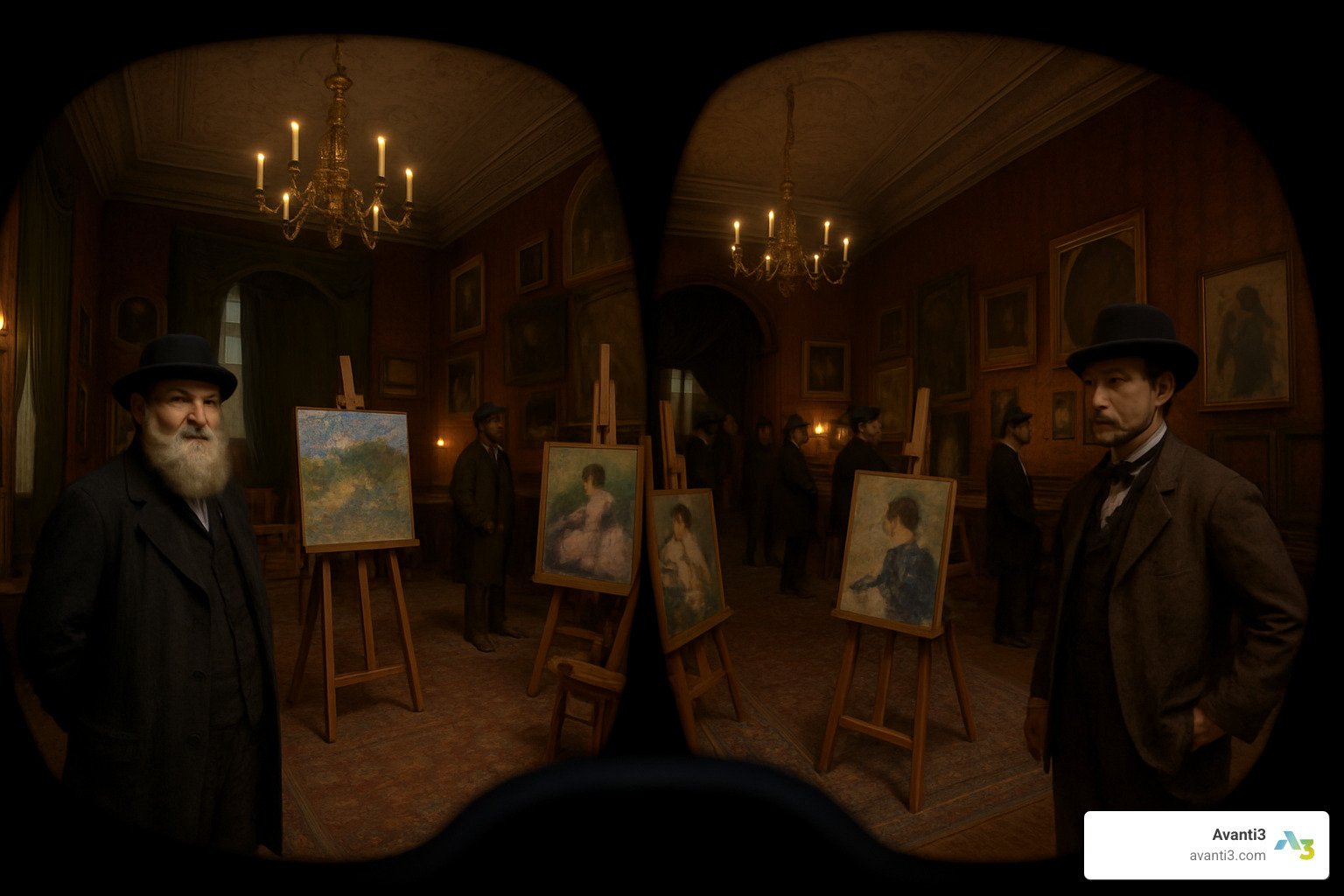
Behind the Scenes of this virtual reality museum recreation
The creation of this experience was no small feat. Museum staff dove deep into historical archives to bring 1874 Paris back to life with remarkable accuracy.
The team pored over historical documents, period photographs, and first-hand accounts to faithfully recreate Nadar’s studio exactly as it would have appeared on that pivotal night. What makes this experience particularly special is that it doesn’t stop at the exhibition – you can virtually visit Bazille’s studio, explore the island of Grenouillère where many Impressionists painted, and wander through Le Havre, Monet’s inspirational coastal hometown.
The technical aspects are equally impressive. Developers built convincing 3D models of spaces that no longer exist in their original form, using whatever historical evidence they could find. When you slip on the headset, the motion controllers let you interact naturally with the environment – pick up objects, gesture to characters, and feel genuinely present in this pivotal moment in art history.
Why this virtual reality museum experience stands out
“Tonight with the Impressionists” showcases exactly why virtual reality museums are reshaping cultural experiences in ways traditional exhibitions simply can’t match.
The experience has been a hit with younger visitors who might normally walk right past Impressionist paintings. There’s something about the interactive, game-like quality that resonates with digitally-native generations, making 150-year-old art suddenly relevant and exciting.
This aligns perfectly with research showing that 79% of people are eager to use digital technology to explore museum collections in new and innovative ways. Rather than replacing physical museums, these experiences complement them by offering something entirely different.
One often overlooked gem of this experience is its incredible soundscape. The developers carefully crafted the ambient sounds of 19th-century Paris – from horse-drawn carriages on cobblestone streets to the excited murmurs of exhibition attendees. These audio details create a profound sense of “being there” that deepens your connection to this pivotal moment in art history.
3. Kremer Museum – Fully Digital Old Masters Gallery
The Kremer Museum represents a approach to the virtual reality museum concept – it exists exclusively in virtual space, with no physical counterpart. Created by art collectors George and Ilone Kremer, this virtual museum houses their collection of Dutch and Flemish Old Master paintings from the 17th century.
Each of the 70+ paintings has been digitized using photogrammetry techniques, capturing over 2,500 high-resolution photographs per painting to create incredibly detailed 3D models. The virtual architecture was designed specifically to showcase these works in optimal lighting conditions impossible to achieve consistently in a physical space.
What makes the Kremer Museum particularly innovative is its social VR capabilities. Multiple visitors can explore the space simultaneously, sharing the experience and discussing the artworks together despite being physically located in different parts of the world.
Highlights & Takeaways
The Kremer Museum demonstrates several key advantages of the fully virtual approach:
No Physical Building: By eliminating the need for a physical structure, the Kremer Museum avoids the enormous costs of construction, maintenance, security, and climate control typically associated with housing priceless artworks.
70 Paintings in Perfect Detail: Each artwork is presented in perfect lighting conditions with unlimited viewing angles. Visitors can get centimeters away from the canvas to examine brushwork details invisible to the naked eye in traditional museum settings.
Global Access: The collection is simultaneously accessible to anyone with a VR headset, regardless of geographic location. This democratizes access to these masterpieces beyond what any physical museum could achieve.
As George Kremer explained, “We wanted to create the optimal viewing experience for our collection. VR technology allowed us to build a museum with perfect lighting, unlimited space, and global accessibility – something simply impossible in the physical world.”
4. British Museum – Interactive VR Highlights
The British Museum, home to one of the world’s most comprehensive collections of human history and culture, has acceptd virtual reality museum technology to make its vast holdings more accessible and engaging.
Their VR offerings allow virtual visitors to examine iconic artifacts like the Rosetta Stone in unprecedented detail, explore Egyptian mummy cases from angles impossible in the physical museum, and take 360-degree tours of galleries customized to specific interests or educational needs.
What distinguishes the British Museum’s approach is the layering of educational content within the VR experience. As visitors approach different objects, they can access detailed information, historical context, and even animations showing how artifacts were created or used in their original settings.
Student-Focused Features
The British Museum has particularly excelled at developing VR content specifically for educational use:
Guided Modules: Teachers can select from curriculum-aligned virtual tours that focus on specific historical periods or cultures, complete with suggested discussion topics and activities.
Quiz Activities: Interactive elements test knowledge acquisition as students progress through virtual exhibits, gamifying the learning experience while reinforcing key concepts.
These educational features align perfectly with Avanti3’s Virtual Art Experiences approach, which emphasizes engaging, interactive content that goes beyond passive viewing to create meaningful learning opportunities.
As one teacher reported after using the British Museum’s VR content with her class: “My students retained more information from the 30-minute virtual tour than from weeks of traditional classroom instruction. The ability to ‘handle’ artifacts virtually created a connection to history that textbooks simply cannot match.”
5. Tate Modern – “Modigliani VR: The Ochre Atelier”
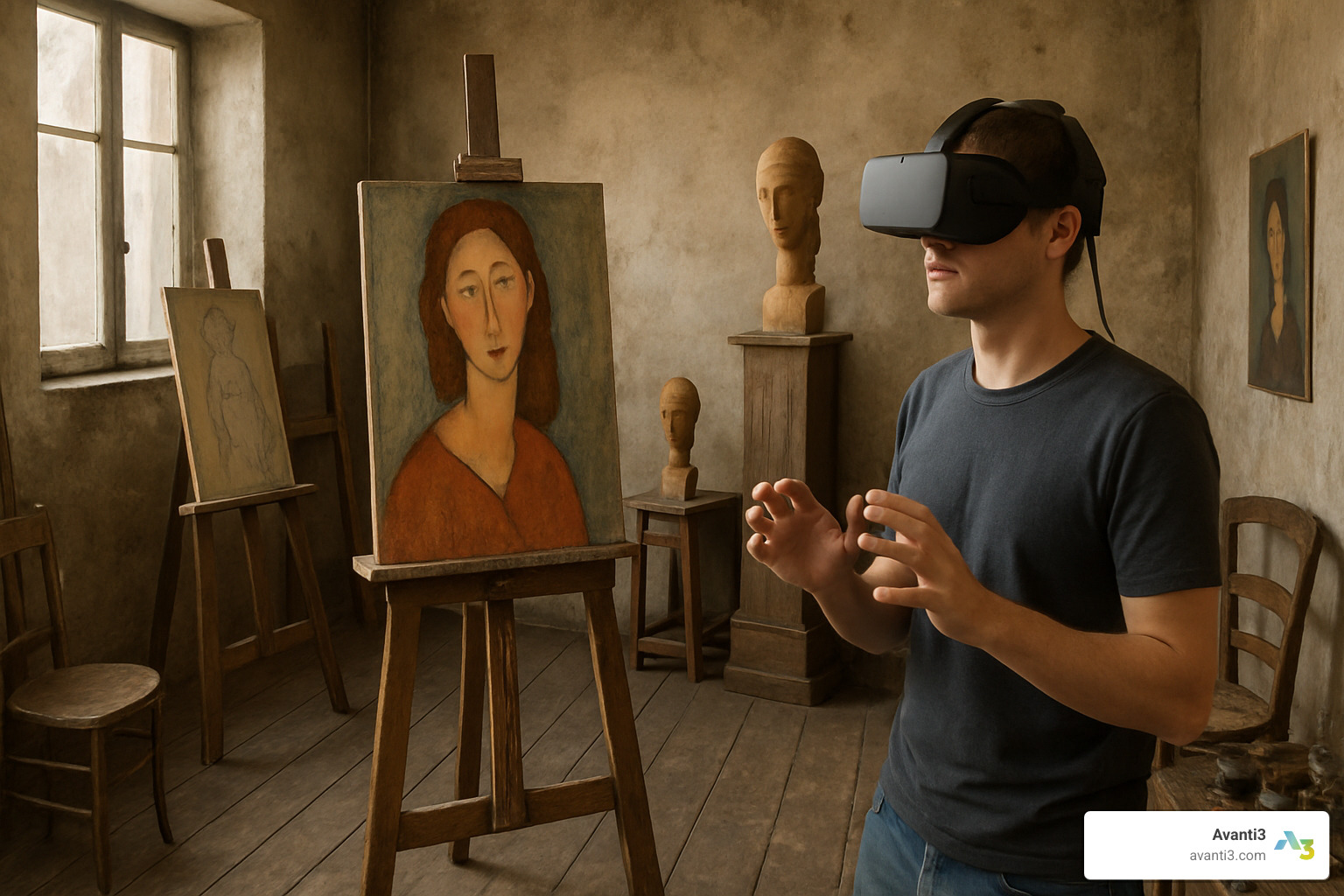
Step into 1919 Paris and find the intimate creative space of one of the 20th century’s most distinctive artists. The Tate Modern’s “Modigliani VR: The Ochre Atelier” offers visitors a rare glimpse into Amedeo Modigliani’s final studio, lovingly reconstructed through meticulous historical research.
This virtual reality museum experience goes beyond simply displaying finished artworks. Instead, it invites you to understand the man behind the masterpieces by exploring his living and working environment. The modest, somewhat cramped quarters immediately tell a story about the challenging conditions under which Modigliani created his now-celebrated works.
What makes this experience truly special is the attention to detail. Everything from his painting materials scattered about to the worn furniture and personal belongings has been carefully recreated. You’ll see his distinctive elongated portraits and sculptures at various stages of completion, offering insights impossible to gain from viewing finished works in traditional gallery settings.
There’s something profoundly moving about standing in this virtual space, hearing the ambient sounds of early 20th-century Paris filtering through the windows, and realizing that this is where artistic magic happened—a place that physically no longer exists but has been brought back to life through technology.
Art Process Revealed
The true brilliance of “The Ochre Atelier” lies in how it unveils the artistic process behind Modigliani’s distinctive style.
With brush-stroke clarity that would be impossible in a traditional museum setting, visitors can lean in close to examine Modigliani’s techniques in extraordinary detail. You can study how he built up layers of paint, observe his characteristic outlining methods, and appreciate the subtle color choices that give his portraits their haunting quality. This level of examination goes far beyond what would be permitted with priceless originals protected behind barriers and glass.
The experience is further improved through ambient ambisonics—a sophisticated 3D audio technology that creates a convincing soundscape of 1919 Paris. Street vendors call out below the windows, neighbors’ footsteps creak overhead, and period-appropriate music plays softly from a virtual gramophone in the corner. These auditory details help transport visitors completely into Modigliani’s world.
“Virtual reality allows us to transcend the limitations of traditional exhibitions,” explains Frances Morris, Director of Tate Modern. “For an artist like Modigliani, whose physical spaces have been lost to time, this technology provides invaluable context that deepens our understanding of his vision and working methods.”
The scale and context provided by this virtual reality museum experience help visitors better appreciate why Modigliani’s portraits look the way they do—how his physical surroundings, materials, and daily life influenced the development of his unmistakable style. It’s a powerful reminder that great art doesn’t emerge from a vacuum but is shaped by the very specific circumstances of its creation.
6. Smithsonian – “No Spectators: The Art of Burning Man”
The Smithsonian American Art Museum took an innovative approach to extending the life and reach of their “No Spectators: The Art of Burning Man” exhibition through virtual reality museum technology.
This physical exhibition featured large-scale installations, sculptures, and immersive environments inspired by the annual Burning Man event in Nevada’s Black Rock Desert. Due to the massive scale of many pieces, only a fraction of the artwork from Burning Man could be physically displayed in the museum.
The VR component allowed visitors to experience the full scale of these monumental works in their original desert setting, providing context impossible within museum walls. Additionally, after the physical exhibition closed, the VR experience remained available, preserving access to these temporary installations.
Lessons for Future Exhibits
The Smithsonian’s approach offers valuable insights for museums considering virtual reality museum implementations:
Temporary Shows, Permanent Access: By capturing temporary exhibitions in VR, museums can extend their lifespan indefinitely, allowing continued access long after physical displays have been dismantled.
Digital Lifespan: The digital preservation of ephemeral art installations (like those at Burning Man, which are burned at the event’s conclusion) creates a permanent record of works that would otherwise exist only in memory and photography.
This strategy aligns perfectly with Avanti3’s AR/VR Immersive Experiences philosophy, which emphasizes using immersive technology to transcend physical limitations and preserve cultural experiences for future generations.
As Sara Snyder, Chief of External Affairs and Digital Strategies at the Smithsonian American Art Museum, noted: “Virtual reality allows us to document and share art experiences that are inherently temporary or site-specific. It’s not just about recreating what’s in our galleries—it’s about extending our mission to preserve and share art that might otherwise be inaccessible.”
How to Create Your Own VR Museum Tour
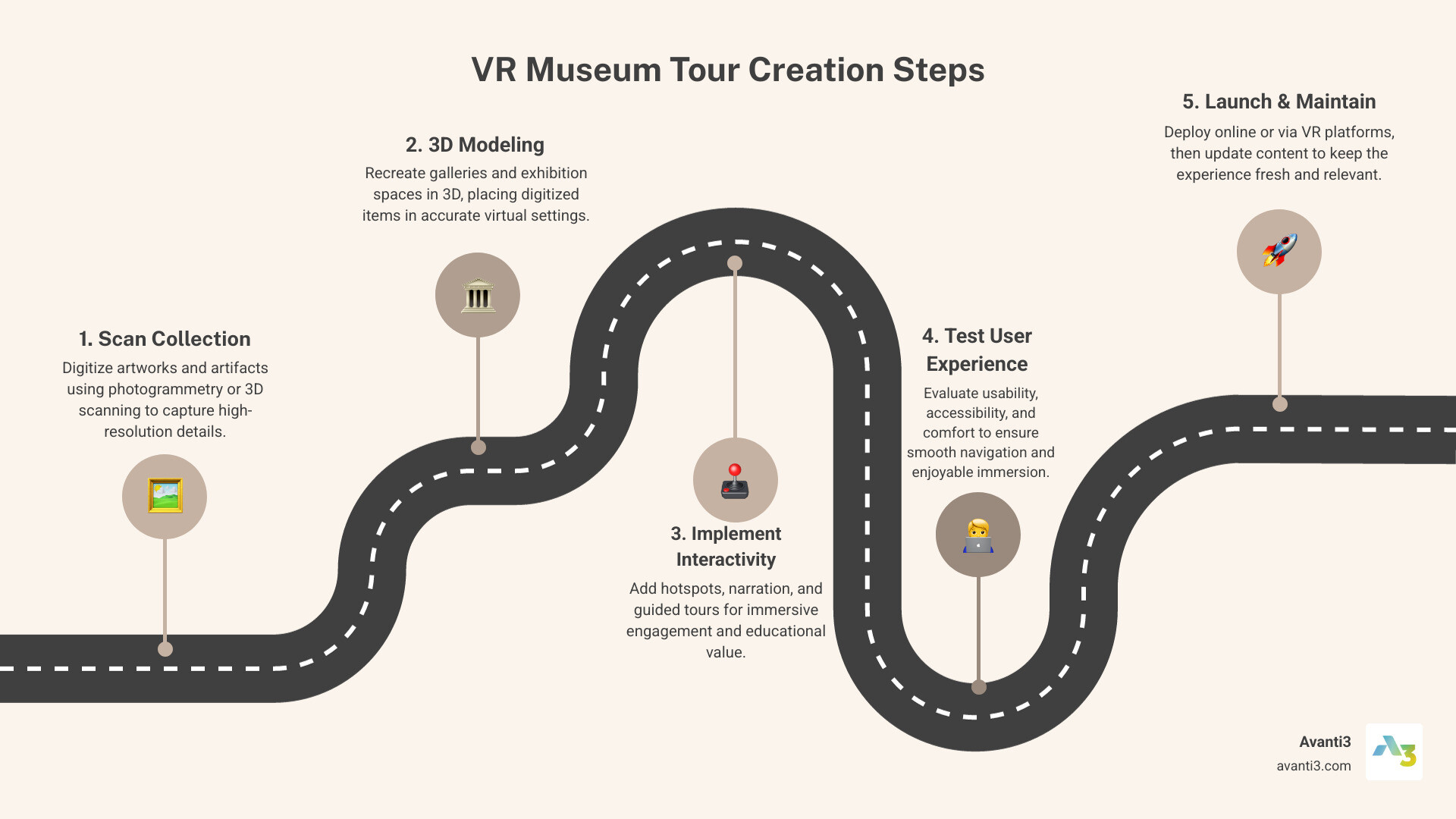
Gone are the days when creating a virtual reality museum experience required a Hollywood-sized budget and a team of technical wizards. Today, institutions of all sizes can bring their collections into the virtual field with the right approach and tools.
While the magnificent VR experiences at the Louvre or Musée d’Orsay represent the high end of what’s possible, there’s a whole spectrum of options that can work with more modest resources. The key is understanding the basic workflow and scaling it to fit your needs.
The journey begins with digitizing your collection. Using photogrammetry, you’ll capture hundreds of high-resolution photographs of each object from multiple angles, with consistent lighting being absolutely crucial for flat artworks. This process transforms real-world artifacts into detailed digital twins that visitors can examine from any angle. For three-dimensional objects like sculptures, these multiple images allow specialized software to generate astonishingly detailed 3D models.
Next comes the virtual environment itself. Platforms like Unity or Unreal Engine provide the foundation for building interactive spaces where your digitized artifacts can live and be explored. Think of these engines as the digital equivalent of museum architecture – they determine how visitors move through space, interact with objects, and experience your collection.
For maximum accessibility, consider WebVR implementation. This approach delivers VR experiences through standard web browsers, eliminating the need for visitors to download specialized apps. While WebVR has some limitations compared to dedicated applications, it dramatically lowers the barrier to entry for first-time users.
Action Plan
If you’re serious about developing your own virtual reality museum experience, I recommend starting with a thoughtful content strategy. Not everything in your collection will benefit equally from VR presentation. Focus first on items that tell compelling stories or offer unique viewing opportunities.
Consider prioritizing fragile artifacts that can’t withstand regular handling, objects with interactive or multisensory aspects, items that would benefit from historical context, or treasures currently languishing in storage due to space limitations. These categories typically deliver the highest value in a virtual environment.
User testing is absolutely essential. I’ve seen brilliant concepts fall flat because they weren’t tested with real people before launch. Develop prototypes and invite diverse user groups to try them, paying close attention to how intuitively they steer, whether information feels overwhelming, and if anyone experiences discomfort during use. This feedback is gold for refining your experience.
Don’t forget about the unglamorous but critical maintenance aspects. Establish clear protocols for sanitizing headsets between users, keeping software updated, and refreshing content periodically. A neglected VR installation can quickly become an embarrassing relic rather than an impressive innovation.
At Avanti3, our Digital Experience Design team loves guiding cultural institutions through this entire process. We believe the most effective virtual reality museum experiences start with clear objectives and thoughtful curation, with technology serving as the enabler rather than stealing the spotlight. The magic happens when visitors forget they’re wearing a headset and become completely absorbed in your collection.
Frequently Asked Questions about Virtual Reality Museum Tours
What equipment do I need at home?
Wondering what you’ll need to start on your own virtual reality museum trip from your living room? Don’t worry—it’s simpler than you might think!
For beginners, you can start with just the basics: a smartphone with gyroscope capabilities (most modern phones have this), a simple VR viewer like Google Cardboard (which costs about as much as a pizza), and a decent internet connection. Many museums have designed their virtual experiences to be accessible through these entry-level setups, allowing you to download their app or access WebVR content through your browser.
If you’re ready to dive deeper into more immersive experiences, you might consider investing in a dedicated VR headset like an Oculus Quest or HTC Vive. These premium setups offer significantly improved visuals and interactivity, though they do require more space and a heftier initial investment. The motion controllers that come with these systems let you reach out and interact with virtual objects—imagine picking up and examining a Roman artifact or sketching alongside Picasso!
I’ve found that many first-time users are surprised by how engaging even the simpler smartphone-based experiences can be. As one visitor told me after trying the British Museum’s VR tour on her phone: “I expected something clunky, but within minutes I forgot I was sitting on my couch. I felt like I was actually walking through the Egyptian galleries!”
Will VR replace physical museum visits?
This is perhaps the most common question I hear, and the answer is reassuringly clear: virtual reality museum experiences are designed to complement physical visits, not replace them.
Think of VR as opening new doors rather than closing existing ones. These virtual experiences excel at reaching people who might never have the opportunity to visit in person—whether due to distance, mobility issues, or financial constraints. They offer previews that often inspire people to plan actual visits, having developed a curiosity about specific works they finded virtually.
VR also shines when showcasing items too fragile for regular display or currently in storage. As one museum director put it, “Our storage facilities hold 90% of our collection. VR lets us bring those hidden treasures into the light without physical risk.”
The emotional connection of standing before an original artwork remains powerful and irreplaceable. Terry Karges from the Peterson Automotive Museum explains it perfectly: “Our VR experiences don’t compete with physical visits—they improve them. Many visitors try our Ford GT40 VR experience, then immediately want to see the real car in our gallery with newfound appreciation for its history and engineering.”
How do museums keep headsets hygienic?
With hundreds of visitors potentially using the same VR equipment daily, museums have developed thorough hygiene protocols that have only strengthened since the pandemic.
Most institutions now use disposable face masks that create a barrier between your skin and the headset. These lightweight liners are replaced between each user, similar to the paper covers used on medical equipment. Staff members are typically trained to assist with proper fitting and to clean equipment between uses with antibacterial wipes.
Behind the scenes, many museums have invested in UV sterilization boxes that provide deeper disinfection during breaks and after closing. Some forward-thinking institutions have even created innovative solutions like personal VR viewer programs, where frequent visitors can purchase and store their own face cushions at the museum—similar to how some bowling alleys let you keep your own shoes on file.
During my visit to the Louvre’s VR experience last year, I was impressed by their thoughtful approach. A staff member offered me a fresh mask liner, helped adjust the headset comfortably, and I noticed another team member thoroughly cleaning returned equipment before it was offered to the next visitor. These small but important details help ensure that exploring a virtual reality museum remains a comfortable experience for everyone.
Conclusion
The rise of virtual reality museums is truly one of the most exciting cultural developments we’ve seen in generations. From standing face-to-face with the Mona Lisa at the Louvre to traveling back to 1874 Paris with the Impressionists, these technologies are changing how we connect with our shared cultural heritage.
I’m genuinely excited about what’s coming next for VR in museums. As the technology continues to evolve, we’ll see increasingly sophisticated experiences that make learning feel like an trip. These immersive journeys will make art and history more accessible to people of all backgrounds and abilities around the world.
VR isn’t here to replace traditional museum visits. Rather, it’s a powerful companion that extends a museum’s reach, preserves temporary exhibitions, and creates entirely new forms of engagement that physical spaces simply cannot offer. When you consider that roughly 90% of museum collections sit in storage at any given time, VR becomes an incredible opportunity to bring hidden treasures into public view.
For museums considering the VR journey, the path forward is becoming increasingly clear and accessible. At Avanti3, our team specializes in creating immersive digital experiences that honor cultural heritage while embracing technological innovation. We’ve developed a Web3-integrated approach that allows virtual reality museum experiences to incorporate additional engagement layers – from NFT collectibles to blockchain-verified provenance information and community-building opportunities.
As Fergus Bruce from the Museum in My Pocket project so perfectly put it: “Our research demonstrates a clear appetite for virtual access and engagement with collections. These are important findings for any collections or custodians looking to increase the reach, impact, and sustainability of the cultural materials they hold.”
The virtual museum revolution isn’t just coming – it’s already here, making our cultural heritage more accessible, engaging, and relevant than ever before. And I, for one, couldn’t be more thrilled to be part of this change.
To learn more about how Avanti3 can help your institution develop compelling virtual reality experiences, visit our AR/VR Immersive Experiences page.



